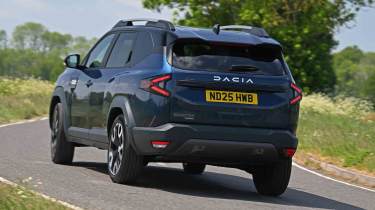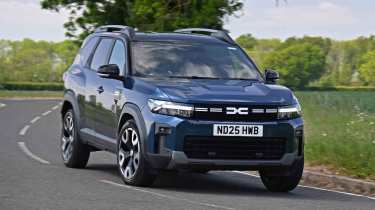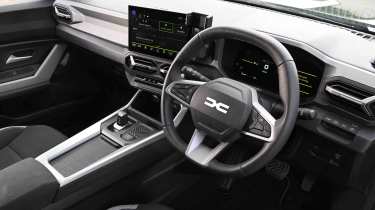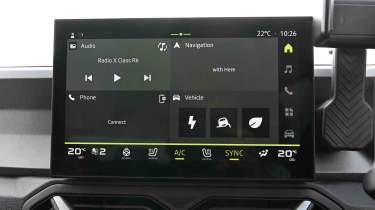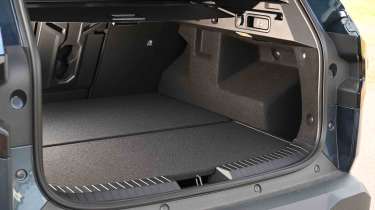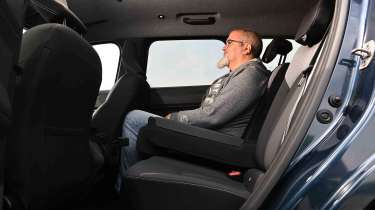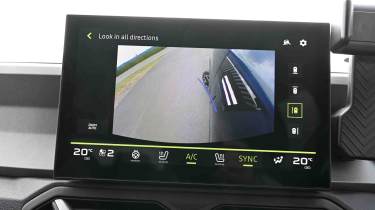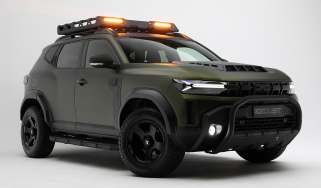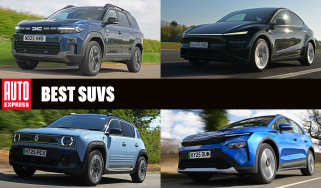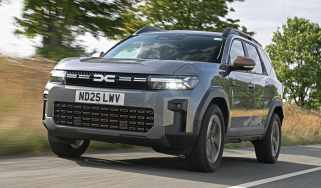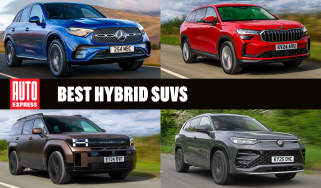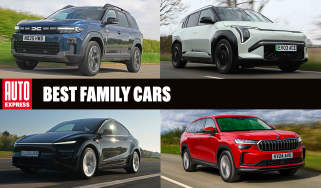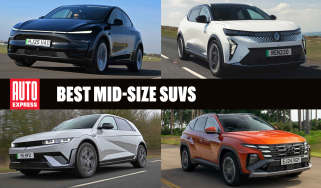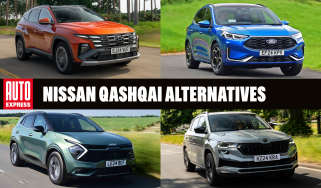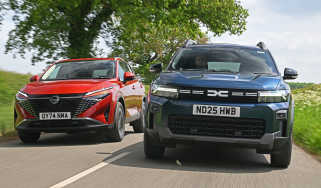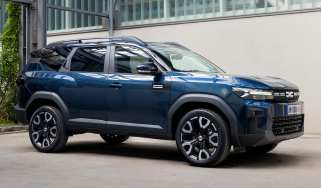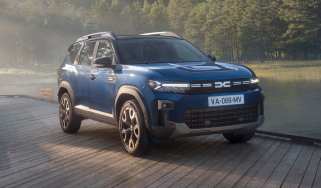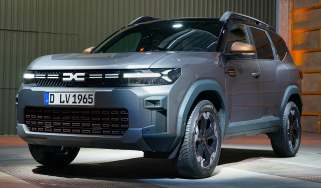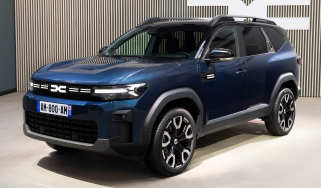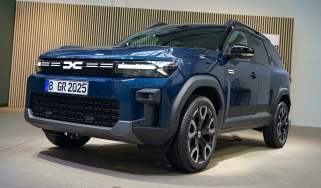Dacia Bigster review
The Dacia Bigster is what the name suggests: a big Duster. But that’s far from a bad thing

Our opinion on the Dacia Bigster
If ever there was a car with a name that reflects its intent, the Dacia Bigster is it. Basically, if you need more space than a Dacia Duster can deliver, then the Bigster fits the brief for a couple of thousand pounds extra.
Like the Duster, the Bigster comes with distinctive, chunky styling, efficient powertrains and user-friendly tech. It has similar levels of kit, too, but there’s more space for families to stretch out and take their belongings with them.
The ride can be a little fidgety at lower speeds, the cabin is clearly built to a price, and the hybrid powertrain is a little noisy in certain situations. But as well as being surprisingly good off road, the Bigster also offers great value for money that means it’s easy to overlook its shortcomings.
About the Dacia Bigster
Sitting above the Spring, Sandero, Jogger and Duster in the Dacia range, the Bigster is the brand’s range-topping model.
It sits on on the same CMF-B platform as the Duster and the engine line-up is similar too: a mild-hybrid 1.2 TCe manual powertrain available with front or four-wheel drive, or a full-hybrid based around a 1.8-litre petrol engine, with an auto and front-wheel drive. A plug-in hybrid Bigster with all-wheel drive has been mooted for the future too.
Although it is bigger than the Duster, the Bigster is a strict five-seater. If you want a seven-seat Dacia, you’ll have to go for the Jogger instead.
Despite the Bigster only just arriving in the UK, we’ve already tested it against the Nissan Qashqai, where the Dacia took victory. It was also a commended car in the mid-size SUV category of our Car of Year Awards.
Dacia Bigster prices and latest deals
As a mid-sized family SUV, the Bigster has plenty of rivals, including the excellent Kia Sportage and Hyundai Tucson, plus the Citroen C5 Aircross, MG HS and aforementioned Nissan Qashqai. The Bigster retains Dacia’s reputation for value though, because it undercuts all of those cars, offering a starting price of around £25,000 with the mild-hybrid 1.2 TCe, which is roughly £3,500 more than the Duster with the same engine. As with the smaller car, adding four-wheel drive costs around £2,500, while the hybrid model starts at a fraction over £28,000.
Unlike the Duster, there is no basic Essential variant, so the range kicks off with Expression trim, followed by Journey and then Extreme.
Although the car has only just been launched, there are already loads of appealing deals on the Auto Express Buy A Car service for every version of the Dacia Bigster right now.
Performance & driving experience
Pros |
|
Cons |
|
Given that its platform and powertrains are shared with the Duster, it will come as no surprise to learn that the Bigster has similar manners on the road. It’s not particularly fast, but it has enough power to keep pace with traffic, while refinement is reasonable at most speeds. There’s an unsettled nature to the ride at lower speeds, but it smooths out the faster you go.
Performance, 0-60mph acceleration and top speed
Neither powertrain delivers punchy performance, but there’s enough to get by. The 1.2 TCe mild-hybrid manual has 138bhp and 230Nm of torque, which is good enough for a 0-62mph time of 9.8 seconds; adding four-wheel drive sees the total power output drop a little, to 128bhp, but torque remains the same. With less power and more weight, the added traction of four-wheel drive can’t overcome this deficit, and 0-62mph takes 11.2 seconds.
That sounds pretty sluggish, but from our experience of the 4x4, the Bigster keeps up with traffic perfectly well and it's only 0.2 seconds slower to 62mph than the Duster 4x4. There’s a sensation that the turbocharger is doing much of the heavy lifting next to the 4x4’s three-cylinder engine, so it’s important to get in the right gear – which is easy because the six-speed manual is pleasant enough, despite the overly-spongey clutch pedal.
The hybrid model features a powertrain that’s new to the Renault group, because it’s based on a 1.8-litre four-cylinder, rather than the 1.6-litre unit that is used by the Duster hybrid. It makes 153bhp and 205Nm of torque, but is assisted by an electric motor, so this version can sprint from 0-62mph in 9.7 seconds. As with rival hybrid systems, the electronics juggle between EV, hybrid and petrol modes at all times, and as a result the Bigster’s engine note doesn’t necessarily synchronise with the car’s acceleration. There are no complaints about the car’s power delivery, though, with linear acceleration from a standstill, and a fair amount of engine noise at full throttle. All versions of the Bigster have a top speed of 112mph.
| Model | Power | 0-62mph | Top speed |
| 1.2 TCe | 138bhp | 9.8s | 112mph |
| 1.2 TCe 4WD | 128bhp | 11.2s | 112mph |
| 1.8 Hybrid | 153bhp | 9.7s | 112mph |
Town driving, visibility and parking
At low speeds there’s a fidgety edge to the Bigster’s ride when the road surface is poor, and this is amplified by the large 19-inch wheels and relatively low-profile tyres fitted to Expression trim. It’s not overly harsh, but is the part of the driving experience where the Bigster’s budget roots most obviously show through.
The powertrain is great, though. Keep your speed sensible and throttle inputs gentle, and you’ll rarely hear the engine firing up. When it does, the engine cuts in smoothly and with a distant hum, so the cabin stays hushed at low speeds.
Light steering boosts the car’s manoeuvrability, although we found the high-set bonnet made it slightly tricky to position the nearside of the car against a kerb. Expression cars feature side parking sensors that help you find the side of the road, though.
Country road driving and handling
Quick steering and a floaty sensation to the ride mean that the Bigster isn’t really a car that offers much in the way of fun along a B-road. The damping settles down at higher speeds, though, which boosts comfort, but the tall ride height and soft set-up translate into plenty of body roll in corners. There’s decent weight to the steering and grip is good, but the amount of lean in bends will deter you from pushing the car really hard.
There’s more off-road ability in the Bigster than in many of its rivals and the 4x4 variant impressed us with its ability over the rough stuff. A relatively light 1,428kg kerbweight helps the Bigster scamper over ruts and bumps, and our car’s all-terrain tyres showed no signs of getting stuck. Along with an impressive 219mm ground clearance, the Bigster’s approach angle of 24 degrees and departure angle of 29 degrees, along with a ramp angle of 23.2 degrees, are the best you’d find this side of a Land Rover Defender and Mercedes G-Class.
Motorway driving and long-distance comfort
The Bigster is a decent cruiser at motorway speeds, with a floating sensation to the ride that boosts comfort. The hybrid model switches between petrol and EV drive even at 70mph, with no hesitation in the powertrain as you accelerate, because the electric motor takes the strain ahead of the engine, and only a small amount of vibration can be felt when the four-cylinder cuts in. There’s only one degree of brake regeneration in the hybrid, though, thanks to ‘B’ mode - we’d prefer a selection of different strengths.
There’s wind noise from the door mirrors at speeds of around 55mph and above. And while Expression models on 19-inch wheels do suffer from a bit of tyre noise, smaller wheels do help with minimising road noise.
“The hybrid powertrain works well in the Bigster. While there’s a larger-capacity petrol engine under the bonnet, the car still favours electric drive most of the time, especially at lower speeds. The benefits can be felt at higher speeds, where the electronics swap between the engine and electric motor where necessary, with one taking a load of the other and vice versa. We’d like to see some sort of multi-stage energy recuperation, though, because at the moment there isn’t any.” – Dean Gibson, senior test editor, tested the Dacia Bigster against the Nissan Qashqai
MPG & running costs
Pros |
|
Cons |
|
As well as offering a lot of car for the money, the Bigster delivers some impressive fuel economy figures, especially in hybrid guise. Officially, the poorest performer in the line-up is the 4WD 1.2 TCe mild hybrid, which returns 46.0mpg. Next up is the slightly more powerful front-wheel-drive 1.2 TCe, which can return a claimed 50.0mpg. However, in the real world we’d expect these engines to struggle to meet their respective WLTP figures. The Bigster is a relatively large car, and past experience says that small-capacity turbocharged three-cylinder units such as the Renault Group’s TCe need to be worked harder than you might expect.
The hybrid model is better suited to the Bigster, and the official fuel economy of 58.0mpg is impressive for a car of this size. Dacia claims that the Bigster’s relatively low kerbweight contributes to this, with all models being around 150kg lighter than similar cars in the class. Interestingly, the official fuel consumption figures remain the same whichever trim level you choose.
During our time with the Bigster hybrid in Expression trim, we easily managed to achieve 53-54mpg even with a lot of motorway driving and no special focus on fuel efficiency. In normal driving, it’s obvious that the powertrain favours electric drive as often as possible, and a small ‘EV’ logo is shown in the bottom corner of the dash when the car is running on its electric motor alone. As for the TCe 130 4x4, we saw 44mpg on the motorway (almost matching the claimed 46mpg), although it dropped to 42.5mpg after some town driving.
| Model | MPG | CO2 | Insurance group |
| TCe 140 | 50.0mpg | 122g/km | 27 |
| TCe 130 4WD | 46.0mpg | 134g/km | 26 |
| Hybrid 155 | 58.0mpg | 105g/km | 28 |
Insurance groups
Group ratings for the Bigster align with the powertrain chosen. The mild hybrid is in group 27, while adding four-wheel drive and reducing power puts the car in group 26. The more complex hybrid model falls into group 28. These group ratings are on the high side when compared with some rivals.
Tax
All versions of the Bigster fall well under the £40k luxury car tax threshold, even if you add every option going. If you’re looking at the Bigster as a company car, then the low list prices will help keep Benefit-in-Kind costs low, although what’s really needed is a plug-in hybrid variant for rock-bottom emissions-based taxation.
Depreciation
The Bigster has some of the strongest predicted residual values in the new-car market, not just in the compact SUV sector. Top-spec Extreme versions do particularly well, with the hybrid variant currently forecast to retain more than 67 per cent of its value after three years. Even the poorest-performing 4WD model weighs in at 57 per cent.
To get an accurate valuation for a specific model, check out our free car valuation tool...
Interior, design & technology
Pros |
|
Cons |
|
Distinguishing between the Bigster and smaller Duster is easier said than done, unless the two are parked side by side. Both have a rugged look, smart LED daytime running lights and X-themed exterior details that will appeal to SUV buyers, while the tall ride height gives that all-important high driving position.
The Bigster uses chunky design cues inside and out that make a virtue of the hard plastics and fabric trim, which are used throughout the car. But some of the material quality is clearly a step behind that of pricier rivals.
Despite the Bigster’s focus on value, it’s pretty well equipped. The base-level Expression comes with a 10.1-inch touchscreen and seven-inch driver’s display, plus dual-zone air-conditioning, a 40:20:40-split rear bench, front and rear parking sensors, a reversing camera, 17-inch diamond-cut alloy wheels and four ‘YouClip’ anchor points for attaching accessories such as cup-holders, phone mounts and bags.
Mid-spec Journey is our favourite trim, because for around £1,500 extra you get 19-inch alloys, a powered tailgate, a 10.1-inch driver’s display to match the central touchscreen, a heated steering wheel, heated front seats, unique seat upholstery, a wireless smartphone charger, electrically adjustable door mirrors and high-beam assist.
Costing only around £300 more, the Extreme version is well worth a look too. Its adventurous looks are finished off with copper exterior highlights and smaller (and more comfortable) 18-inch wheels than the Journey. It also gets keyless entry, roof bars and a panoramic sunroof that we found breathes a bit more light into that spacious interior. There’s even washable seat upholstery and rubber floor mats to make cleaning up after outdoor pursuits that much easier.
Interior and dashboard design
Despite the Bigster name on the tailgate and the C-pillars, we regularly found people confusing it with a Duster. The two have the same design cues, such as the Y-shaped daytime running lights; it’s just that the Bigster is a bit larger.
It’s a similar story inside, where the Y-shaped theme continues on the air vents and door trims, while the high-set touchscreen and digital dials add a modern edge. Those systems are borrowed from Dacia’s parent company, Renault, and plenty of switchgear is taken from the French brand, too, such as the bank of climate switches on the centre console and the steering column stalk that you can use to adjust the audio settings; even the keycard will be familiar to anyone who’s owned or driven a Renault from the past 20 years.
Materials and build quality
While the cabin looks smart, the material quality in places leaves a little to be desired. There’s not much wrong with how the switchgear works, and the neoprene-style seat fabric feels high-quality to the touch, but there are lots of hard plastics. In places they don’t feel particularly robust.
The rear door handles are another example of questionable perceived quality. These are mounted in the C-pillars, yet they feel a little flimsy – they’re double-hinged for strength, but the plastic grabs flex as you pull the handle open.
There were rattles in the cabin, too, while the driver’s door seal on our car was missing a clip and didn’t sit smoothly with the shut line when the door was closed. It didn’t mean there was extra wind noise, but was another sign that the Bigster is built down to a cost.
The nine plastic YouClip attachments (which are priced from £10 to £41) offer extra storage spaces for smartphone holders, cup-holders or even a removable lamp. They felt flimsy to us and when the smartphone holder was placed on the dash, it rattled on the move.
Infotainment, sat-nav and stereo
The Bigster uses the same touchscreen system as other Dacia and Renault models. Its 10.1-inch display has crisp graphics and clear text, while shortcut keys are positioned in a vertical row on the driver’s side. The system responds reasonably well, but the built-in Here nav is slow to use. Thankfully, wireless smartphone connectivity is fitted so you can bypass Here completely. The set-up wouldn’t always detect our Apple device when it was connected via a cable, but Bluetooth worked fine.
As for the driver’s display, it’s configurable to a degree, with a rather basic trip computer – you can have sat-nav (smartphone or in-car) on the screen however, which we think is a classy touch. In the 4x4 model, there’s also an off-road readout for things including altitude, the slope or tilt of the car, and a compass for when you’re really getting into the wilderness.
“Dacia’s YouClip system features small plastic squares that you can lock different pieces of kit to. There’s one on the dash next to the touchscreen, or you can place the phone mount accessory on the back of the centre console to use it as a screen for back-seat passengers. There are additional YouClips in the boot, while Dacia offers a range of accessories such as a torch, bag, suit hanger and tablet holder.” – Dean Gibson, senior test editor
Boot space & practicality
Pros |
|
Cons |
|
The extra length and wheelbase the Bigster has over the Duster means it also offers more passenger and boot space than you’ll find in a number of more expensive rivals.
Dimensions and size
At 4,570mm, the Bigster is 227mm longer than the Duster and plenty of that has gone into making the rear seat and boot space even more generous. The boxy, upright profile of the Bigster also means that headroom isn’t an issue for tall adults up front or in the back.
Dimensions comparison | |||
| Model | Dacia Bigster | Nissan Qashqai | MG HS |
| Length | 4,570mm | 4,425mm | 4,655mm |
| Width | 1,812mm | 1,835mm | 1,890mm |
| Height | 1,711mm | 1,625mm | 1,664mm |
| Wheelbase | 2,702mm | 2,665mm | 2,765mm |
| Boot space | 612-1,977 litres | 504-1,447 litres | 507-1,484 litres |
Driving position, seats & space in the front
There’s a decent range of seat adjustment, but taller drivers might find the left footrest a little high and a lack of under-thigh seat support might cause some aches on longer trips. There’s a decent view out, too, although the high-set bonnet creates a bit of a blind spot immediately ahead of the car that means it’s better to position the seat a little higher than you might normally have it.
Storage up front is fine, but the door cards’ design means access to the long bins below the armrests is a little tight, while the bins themselves are narrow. There’s a reasonable glovebox – the fuses encroach into the space, but what’s left is quite deep – while the centre armrest is a decent size, with twin cup-holders ahead of it.
Seats & space in the back
There’s a decent range of seat adjustment, but taller drivers might find the left footrest a little high, while a shortage of under-thigh seat support might cause some aches on longer trips. There’s a decent view out, too, although the high-set bonnet creates a bit of a blind spot immediately ahead of the car that means it’s better to position the seat a little higher than you might normally have it.
Storage up front is fine, but the doors’ design means access to the long bins below the armrests is a little tight, while the bins themselves are narrow. There’s a reasonable glovebox, while the centre armrest is a decent size, with twin cup-holders ahead of it.
Access to the rear is good via long, wide-opening doors, and there will be no complaints from passengers about the space in the back. Headroom is plentiful, while legroom is among the best in the class, and there’s good foot space, even considering the ridge in the floor under the front seats.
Occupants are well catered for, too, with twin air vents and USB-C connectors, while the centre section of the back seat folds down to give you twin cup-holders and a couple of angled slots to hold phones – as well as a ski hatch. The rear door bins are a little narrow, though.
Boot space
Journey models get a powered tailgate that opens to reveal a vast cargo area. Its capacity of 612 litres is 140 litres up on the Duster, and ahead of the Nissan Qashqai and Hyundai Tucson hybrid, too. The 4x4 comes with 17 more litres of boot space than the full-hybrid models, but thanks to the all-wheel drive system it’s 48 litres down on the two-wheel-drive mild-hybrid.
There are two false floorboards with enough room below for a space-saver spare wheel, while the rolling load cover can be fixed in two positions. The back seats fold almost flat and can be released via levers set into the sides of the boot, or there are fabric pulls on the shoulders, although these are thin and fiddly to reach from the passenger compartment.
Towing
Some buyers might want to tow with the Bigster, and if you want the maximum towing capacity, you’ll have to choose the non-hybrid version. The Bigster TCe with either two or four-wheel drive will match the 1,500kg braked towing limit of the Duster. The 155 Hybrid tops out at a disappointing 1,000kg, which is only 250kg more than the hybrid Duster.
“If you want to make the most of the Bigster’s improved cabin space over the Duster, then I’d recommend investing in the Sleep Pack. This simple camping kit costs £1,740 and adds a plywood box that contains a rolled-up mattress and blackout window blinds. Simply open the box and fold the back seats, roll out the mattress and fit the window blinds, and you have yourself a car-shaped sleeping area. For £2,090 you can get the Sleep Pack with a tailgate tent, too.” – Dean Gibson, senior test editor
Reliability & safety
Pros |
|
Cons |
|
The Bigster’s Euro NCAP safety score is based on the one achieved by the Duster in 2024, so it only has a three-star rating. There are plenty of advanced safety systems on board, though. Emergency braking with pedestrian, cyclist and motorcycle detection, traffic-sign recognition, lane-change alert and driver-attention warning are included, and the systems aren’t as intrusive as in many rivals.
Dacia created its ‘Zen package’ in 2024 to improve the warranty on its vehicles. With the Bigster, if you get the car serviced at an official Dacia franchise, then it is automatically entitled to 12 months or 18,000 miles of warranty cover. You can cover the Bigster up to its seventh year or for up to 75,000 miles.
| Key standard safety features |
|
| Euro NCAP safety ratings |
|
Buying and owning
Our best buy: Dacia Bigster Hybrid Journey
The hybrid powertrain makes a lot of sense in the Bigster, because it’s efficient and won’t be worked as hard as the 1.2 TCe to make progress. And with such great value, the Journey trim with its extra luxuries is the best choice. The Extreme version isn’t much more expensive, though.
Dacia Bigster alternatives
Considering the combination of the Bigster’s size and price, rivals are few and far between, although there is steady competition for the high-spec hybrid versions. There is the well-equipped MG HS, which offers a plug-in hybrid version with a whopping 75-mile electric range. If you want a similarly sized SUV to the Bigster, then you’ll have to spend around £5,000 more for the likes of the Nissan Qashqai and Kia Sportage, but neither model will be quite as well equipped.
Deals on the Dacia Bigster and alternatives
Frequently Asked Questions
There’s a feeling that you get what you pay for with the Bigster, because it costs more than a Duster, but it offers extra space that boosts its practicality. It’s still cheaper than many similarly equipped compact SUVs, too, while the hybrid model offers impressive efficiency.

